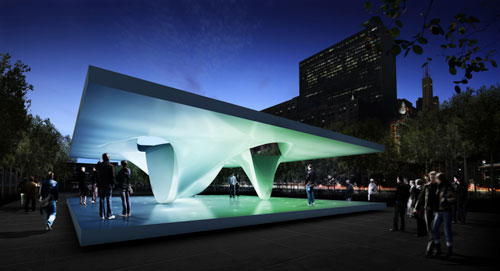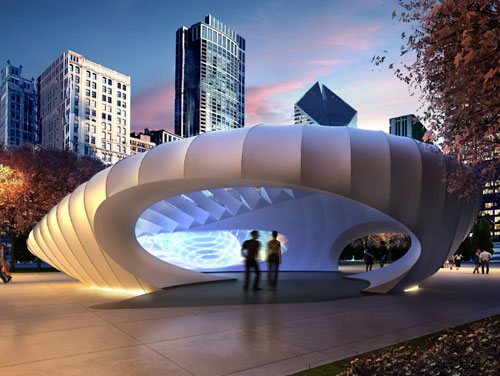Centennial Pavilion Designs Revealed (original) (raw)
Architecture Tue Apr 07 2009
The Burnham Centennial Celebration Committee presented today the first images of the two pavilions that will grace Millennium Park this summer. Designed by "starchitects" Zaha Hadid and Ben van Berkl, the post-modern structures should be huge attractions for those who visit Chicago after June 19th. The Chicago Tribune reported on the unveiling this afternoon at the Chicago Cultural Center.

The pavilion format was a wise choice by the Centennial Committee to allow the designers to be released from the rigidities of function. The result are two dramatically abstract sculptures that should continue the exciting juxtaposition that Millennium Park draws with the firmness of the Michigan Avenue street-wall. Hadid's design appears almost shell-like from ground level and the rendering conveys an experience of fluidity as one might walk through the pavilion. Unlike the explosive, curving sheets of aluminum in Frank Gehry's Pritzker Pavilion, Hadid's design is soft and serene, constructed out of a tensile fabric pull over ribs. Van Berkl's pavilion should draw great similarities to Renzo Piano's Modern Wing at the Art Institute. Just as Piano's "floating carpet" hovers above the new building, van Berkl extends a horizontal plane and then drops tears down for support. Each resultant hole frames a unique or particular view.

If there are any regrets regarding the design it is that they do not appear to be as engaging as other installations in Grant Park. Most sculptural elements invoke the park visitor to interact beyond a visual experience. It is this layering of the tactile and aesthetic that allows Grant Park to be both a gallery of objects and an urban playground. The pavilions appear a bit austere and distanced from these types of purely physical experiences. However, given their temporary nature and their role in the centennial celebration, the pavilions appear poised for success.
